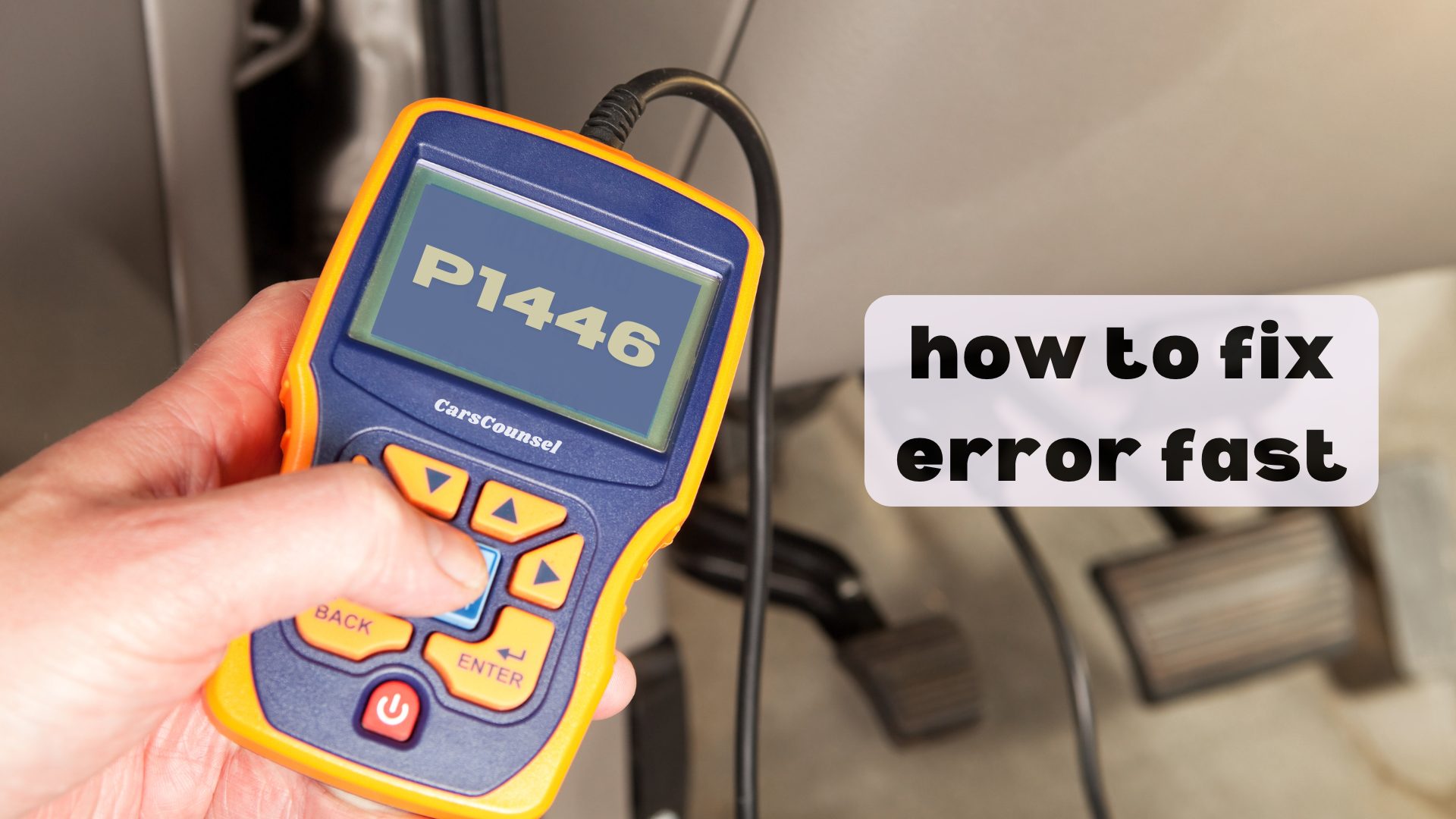Imagine being stuck in a traffic jam, with your car’s engine sputtering and a strong fuel smell wafting through the air – it’s a frustrating and concerning experience. If you’ve recently encountered this issue, you might be wondering what’s causing the problem.
Chances are, your vehicle’s onboard computer has thrown a P1446 code, indicating a fault with the EVAP Canister Vent Control Valve. But what does this valve do, and how can a faulty one lead to such symptoms? You’re about to find out the answers to these questions and more as we delve into the ins and outs of this critical emissions control component.

Quick Navigation
Key Takeaways
- The P1446 code indicates a problem with the EVAP Canister Vent Control Valve, specifically that it isn’t closing properly.
- A faulty Canister Vent Control Valve can cause strong fuel odors, performance issues, and decreased fuel efficiency.
- To diagnose the issue, use a scan tool and perform a visual inspection of the EVAP system components, including the vent valve and vacuum lines.
- Test the Canister Vent Valve by measuring voltage and resistance using a multimeter to determine if it’s closing properly.
- Inspect for leaks and damage in the EVAP system, including the vent valve, charcoal canister, and fuel tank, using leak detection methods.
P1446 Code Description
The P1446 code indicates a problem with the EVAP Canister Vent Control Valve, specifically that it isn’t closing properly.
You should know that the EVAP system helps to capture and store fuel vapors from the fuel tank to prevent their release into the atmosphere, which is vital for emissions regulation.
The Canister Vent Control Valve controls the flow of vapors into the engine. If this valve fails to close properly, fuel vapors can escape, causing emissions issues and potentially affecting your vehicle’s overall performance.
The P1446 code is related to the EVAP system’s inability to properly recirculate fuel vapors. This can lead to decreased fuel efficiency and strong fuel odors, which are pivotal for emissions regulation.
Common Causes Explained
Faulty components within the EVAP system are the primary culprits behind the P1446 code. To fix the issue, you’ll need to identify and address the root cause.
| Common Causes | Description | Effect on EVAP System |
|---|---|---|
| Faulty Canister Vent Control Valve | Malfunctioning valve fails to close properly | Impedes proper recirculation of fuel vapors |
| Vacuum Leaks | Leaks in vacuum lines connected to the EVAP system | Affects valve operation and overall system performance |
| Wiring Issues | Damage or corrosion to wiring or connectors | Disrupts communication between components |
| EVAP System Clogs | Blockages in the EVAP system, such as a clogged vent or charcoal canister | Hinders valve operation and fuel vapor recirculation |
| Other potential causes | Faulty sensors or solenoids | Affects overall EVAP system operation |
These common causes can lead to the P1446 code, so it’s essential to inspect and test the EVAP system components to diagnose the issue accurately.
Symptoms to Watch Out For
Several symptoms will alert you to the presence of the P1446 code, and catching them early can save you from more extensive repairs down the line.
You’ll likely notice a strong fuel odor around your vehicle, which is a clear indication that fuel vapors are escaping due to the faulty Canister Vent Control Valve.
Additionally, you may experience performance issues, such as reduced fuel efficiency, rough idle, or even stalling.
The Check Engine Light on your dashboard will also illuminate, alerting you to the problem.
If you notice any of these symptoms, it’s essential to address the issue promptly to prevent further damage to your vehicle’s engine and EVAP system.
Diagnosing the Issue
When you suspect a problem with the EVAP Canister Vent Control Valve, start by using a scan tool to retrieve the specific error code and perform a visual inspection of the EVAP system components.
This will give you a better understanding of the system’s overall condition and help identify potential issues. The scan tool will provide you with the P1446 code, which indicates a problem with the Canister Vent Control Valve’s closure.
Next, visually inspect the EVAP system components, including the vent valve, vacuum lines, and charcoal canister, looking for signs of damage, corrosion, or blockages.
This initial diagnosis will help you narrow down the possible causes of the issue and guide your next steps in the repair process.
Testing the Canister Vent Valve
Now that you’ve completed a visual inspection of the EVAP system components, it’s time to test the Canister Vent Control Valve‘s functionality.
You’ll need to determine if the valve is closing properly, which is vital for the vent system to operate correctly.
To test the valve, you’ll need a multimeter to measure the voltage and resistance.
Connect the multimeter to the valve’s electrical connector
Turn the ignition on and check the voltage reading
Use a scan tool to command the valve to close and measure the resistance
Compare the readings to the manufacturer’s specifications
Repeat the test several times to verify accurate results
Inspecting for Leaks and Damage
With the Canister Vent Control Valve‘s functionality tested, your next step is to inspect the EVAP system‘s vacuum lines and components for leaks and damage.
Use leak detection methods like a smoke test or a vacuum pump to identify any leaks in the system. Start by inspecting the vacuum hoses, looking for signs of damage, cracks, or loose connections.
Check the vent valve, charcoal canister, and fuel tank for any blockages or restrictions. Use a vacuum hose inspection tool to test the integrity of the hoses and connections.
Any leaks or damage found during this inspection can be causing the P1446 code, so it’s essential to address these issues before moving forward with the repair.
Replacing Faulty Parts
Replacing faulty parts in the EVAP system is a crucial step in resolving the P1446 code.
You’ve identified the faulty Canister Vent Control Valve as the culprit, and now it’s time to replace it. When replacing the valve, certify it’s done correctly to prevent further issues.
- Purchase a replacement valve that meets OEM specifications
- Disconnect the electrical connector and vacuum hoses from the faulty valve
- Remove the faulty valve from the EVAP system
- Install the new valve, guaranteeing proper sealing and connection
- Reconnect the electrical connector and vacuum hoses to the new valve
Clearing Diagnostic Codes
Your scan tool has retrieved the P1446 code and guided you through the diagnosis and repair process. Now, it’s time to clear the diagnostic codes. To do this, you’ll need to use your scan tool to perform a diagnostic reset. This will erase the P1446 code and any other trouble codes stored in the vehicle’s onboard computer.
| Code Clearing Method | Tool Required | Description |
|---|---|---|
| Diagnostic Reset | Scan Tool | Erases trouble codes from the vehicle’s onboard computer |
| Code Clearing | Scan Tool | Deletes specific trouble codes, including P1446 |
| System Reset | Scan Tool | Resets the entire EVAP system to its default state |
| Manual Clearing | None | Not recommended, as it can lead to incomplete code clearing |
Remember to test drive the vehicle after clearing the codes to guarantee the issue has been resolved.
Repair Cost Estimates
Now that you’ve cleared the diagnostic codes, it’s time to focus on the financial aspect of the repair.
You’re likely wondering how much it’ll cost to fix the P1446 code.
- The cost of parts for this repair can range from $100 to $300, depending on your vehicle’s make and model.
- Labor costs may add an additional $100 to $200, depending on the shop’s labor rates.
- On average, the total repair cost can range from $200 to $500.
It’s essential to get quotes from local shops for a more accurate estimate, as labor rates can vary.
Consider consulting factory service manuals or seeking professional diagnosis and repair services for a more precise repair estimate.
Additional Resources Available
Factory service manuals and online forums can provide valuable insights and guidance for DIY enthusiasts and professional mechanics alike, helping you better understand the P1446 code and its repair. These resources can offer detailed diagrams, troubleshooting guides, and repair procedures specific to your vehicle’s make and model.
| Resource | Description |
|---|---|
| Factory Service Manuals | Detailed repair guides, diagrams, and troubleshooting procedures |
| Online Forums | Community-driven discussions, repair experiences, and expert advice |
| Repair Guides | Step-by-step instructions, diagrams, and photos for DIY repairs |
Professional Repair Options
When dealing with complex issues like the P1446 code, seeking the expertise of a professional mechanic can be the most efficient and effective way to resolve the problem.
They’ll have the necessary knowledge and experience to diagnose the issue accurately and perform the required repairs.
- Get online estimates from reputable shops to compare prices and services
- Look for shops with certified technicians experienced in EVAP system repairs
- Check online reviews and ratings to confirm the shop has a good reputation
- Ask about their diagnostic process and what’s included in the repair cost
- Consider shops that offer a warranty on their repairs and parts
More OBD-II Codes
Frequently Asked Questions
Can the P1446 Code Cause Damage to Other Engine Components?
As you diagnose the P1446 code, you’re right to wonder if it can cause damage to other engine components. Yes, a faulty vent system can lead to increased fuel pressure, potentially harming fuel injectors, fuel pumps, and engine cylinders over time.
Will the Check Engine Light Turn off After Fixing the P1446 Code?
Think of your car’s computer like a diligent librarian, keeping tabs on issues. After fixing the P1446 code, you’ll need to reset the Light; otherwise, it’ll persist, like an overdue book. Ensure the code is cleared to turn off the Light and confirm the repair.
Can I Drive My Vehicle With the P1446 Code Active?
While it’s technically possible to drive with the P1446 code active, you risk compromising driving safety and vehicle performance, as fuel vapors escape, affecting emissions and potentially causing rough idling, stalling, or decreased fuel efficiency.
Are There Any DIY Fixes for the P1446 Code Repair?
Notably, 70% of EVAP system issues are caused by faulty vent valves. To DIY fix the P1446 code, you’ll need to inspect and potentially replace the vent valve, ensuring proper closure to prevent fuel vapor leaks in your EVAP system.
Will a Faulty Oxygen Sensor Cause the P1446 Code?
You won’t typically see a faulty oxygen sensor causing the P1446 code, as it’s related to the EVAP system; however, faulty sensor symptoms can indirectly affect vent valve testing, leading to misdiagnosis, so it’s essential to isolate and test the Canister Vent Control Valve separately.
Conclusion
As you navigate the nuances of the P1446 code, keep in mind that faulty fuel flow can fog your fuel efficiency, frustrating your daily drives. Fixing the faulty EVAP Canister Vent Control Valve is vital to clear the code and curb carbon emissions. Consult a skilled mechanic to conduct a meticulous inspection, pinpointing problems and patching pesky leaks.

